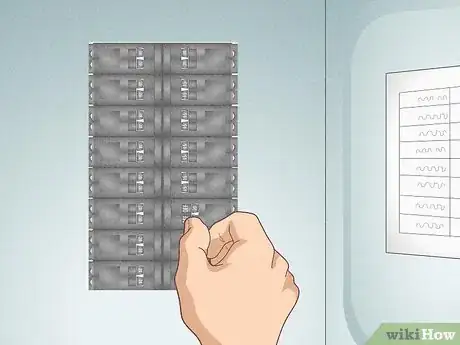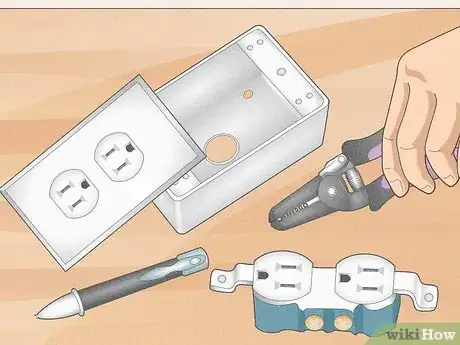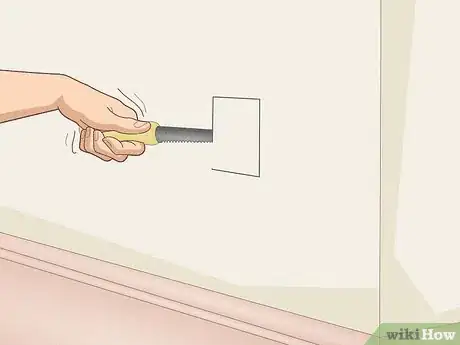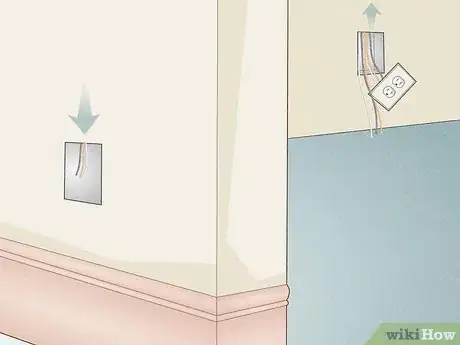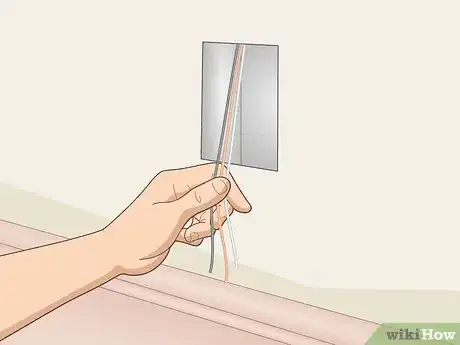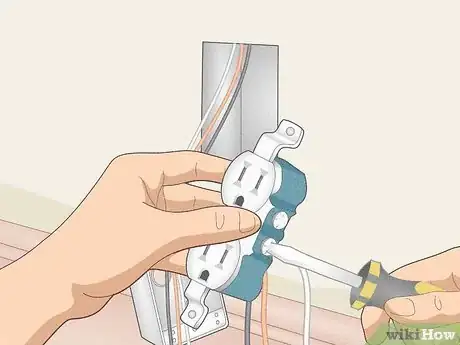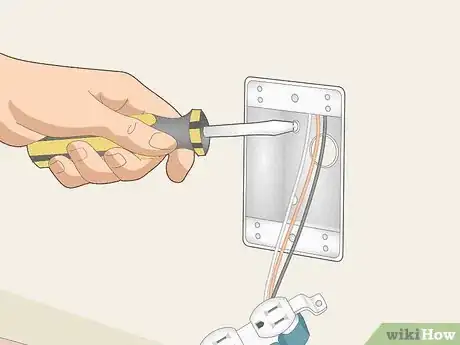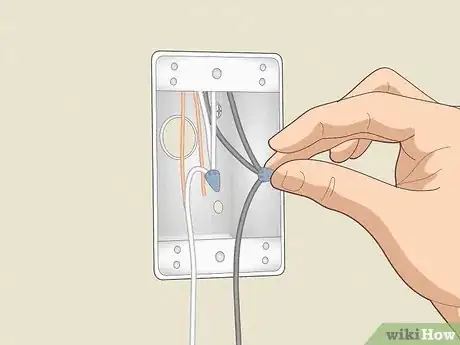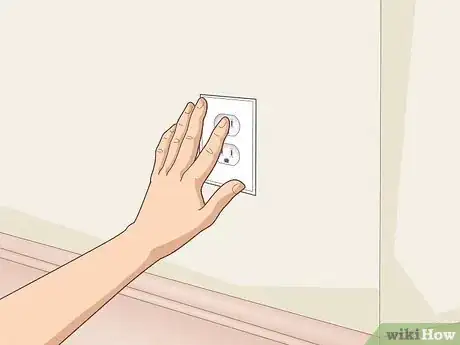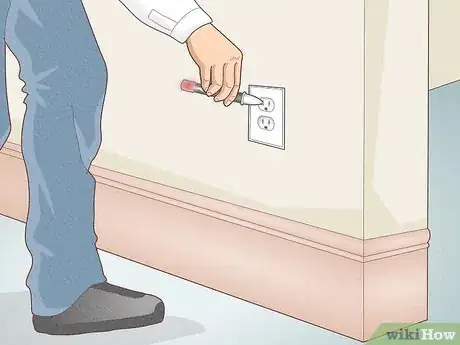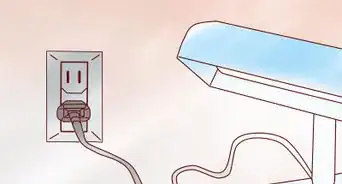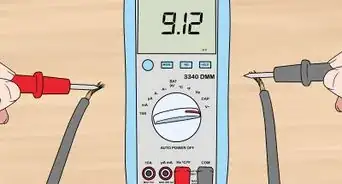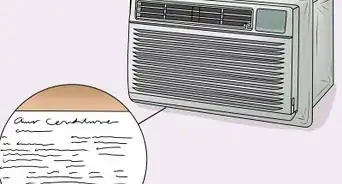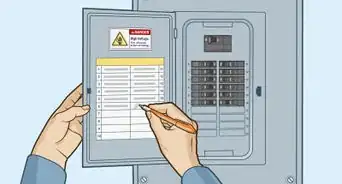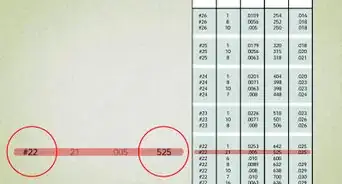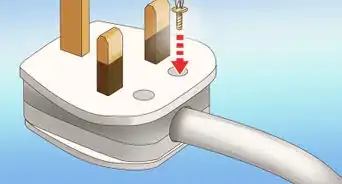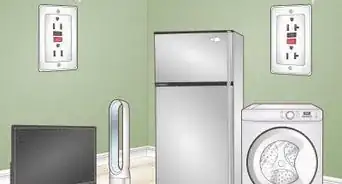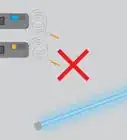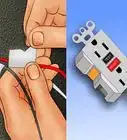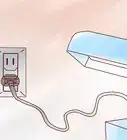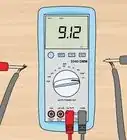This article was co-authored by Ricardo Mitchell. Ricardo Mitchell is the CEO of CN Coterie, a fully licensed and insured Lead EPA (Environmental Protection Agency) Certified construction company located in Manhattan, New York. CN Coterie specializes in full home renovation, electrical, plumbing, carpentry, cabinetry, furniture restoration, OATH/ECB (Office of Administrative Trials and Hearings/Environmental Control Board) violations removal, and DOB (Department of Buildings) violations removal. Ricardo has over 10 years of electrical and construction experience and his partners have over 30 years of relevant experience.
This article has been viewed 414,687 times.
Distributing power outlets evenly throughout a space can open up rooms and make new spaces much more friendly. Placing a new electrical outlet can help make a house more livable. With the right planning and safety precautions, running wire from a power source to a new outlet doesn't need to take more than a couple of hours. Learn to plan the job properly, run wire safely, and test your project to make sure it's secure.
Steps
Planning the Job
-
1Find out if you need a permit or professional installation. Depending on where you live, you may need a permit to add an electrical outlet in your home. In some places, you may need to hire a professional to do any electrical work. Check with your local code office to find out if either of these pertains to your area.
-
2Turn off the circuit breaker. Locate the breaker box in your home, which is usually in a basement, garage, or hallway. Open the box and locate the power switch for the area where you’re working. Flip the switch to the Off position to cut power to the area. Use a non-contact voltage tester to check the circuit before moving forward.[1]Advertisement
-
3Assemble the necessary tools and materials. To install a new electrical outlet and make the connections safely, you'll need a few basic electricians' tools. Make sure you have access to the following:
- Wire strippers
- Keyhole saw
- Drywall knife
- Drill with a wood drill bit
- Lineman’s pliers
- Needle-nose pliers
- Screwdriver, finishing and Philip’s head
- Non-contact voltage tester
- A fish tape
-
4Determine the best location for the outlet. Measure the distance off the floor to the other outlets in the building. Measure from the center of the existing box location to the center of the desired new box location. Turn off the power in the outlet. Take off the cover plate held on by the single screw in the middle of the outlet and measure to the hole cut in the wall.
-
5Find an opening in the wall. In most homes, there are 2 in × 4 in (5.1 cm × 10.2 cm) or 2 in × 6 in (5.1 cm × 15.2 cm) studs typically at 16 or 24 in (41 or 61 cm) increments along any wall. Outlets must always be attached to a stud for security and safety. Mark a space at the appropriate height, at a location between 2 studs.
- The easiest way to locate studs if to use a "stud finder" available at many hardware stores. You can also try tapping the wall lightly with a hammer and moving slowly across the wall and listening closely. The wall will sound hollow for most of the taps and then sound "solid" when you have reached a stud.
-
6Confirm there are no other mechanical or plumbing items in the wall. Check for plumbing from sinks showers or toilets on the opposite side of the wall. Be aware of any HVAC air returns or ducts.
- If there is a grill high up or at the bottom of the wall where you want the outlet, you can't do it with the air return in the same wall space. Explore with a nail hole and hanger. Poke a hole and use something like a wire hanger to "feel" around inside the wall cavity to check.
-
7Find out where you can get power. There are 2 basic ways to install a new electrical outlet, running electrical wiring from a circuit breaker to the new location, or from another outlet in the same room. Depending on where you're installing a new outlet–living space, basement, or outdoor area–access to power may vary. Find the closest and most convenient place to connect to make the job easy on yourself.
- Be sure to consider the existing electrical load and what the new load will add to the existing branch circuit. Calculate the load to ensure it is safe. The most convenient source of power may not be the safest!
- In general, the load for the existing outlet has already been calculated for the circuit, and running a new outlet is likely to overload that circuit. It's typically best to take new wire from the panel and install a new outlet if you need it.[2]
Running Wire
-
1Cut a hole for the new outlet. Trace the outlet box on the wall where you want it to go. Then, use a keyhole saw (or strong utility knife) and make small and firm incisions over and over until you have cut through the wall material. Walls made with plaster may require you to drill holes into the corners and cut the hole with a Sawzall.[3]
-
2Run the wire from the power source to the new outlet. It’s best to avoid making additional holes in the wall if at all possible. Look for ways to extend the branch circuit wiring vertically from the source of power, such as through an attic or basement. Or, use an external method such as conduit or wire mold, or run a fish tape through the hole for the new outlet to run the conductors.
- If you can’t find a way to run the wire, you may have to cut a hole in the wall near the existing power source.
-
3Pull the appropriate kind of wire between the 2 locations. Once you have access to the locations, get your Romex non-metallic wire. Give yourself 12 to 18 inches (30 to 46 cm) of wire sticking out on both ends. Wire the new receptacle first and then go back and connect the new wire to the existing circuit. Cut sheathing off Romex about 8 inches (20.3 cm) long.[4]
- Your home may use 12- or 14-gauge wires. Check the circuit breaker to determine the correct amperage. Note that #14/2+g is 15-amp rated wire and uses a 15-amp circuit breaker, while #12/2+g is 20-amp rated wire and uses a 20-amp circuit breaker.
- You should use wire that is proper for the power rating of that circuit and of the same size as the wire you are connecting to. Take a sample of the existing wire with you when you go to purchase the new wire.
-
4Install the outlet receptacle at the new end. Purchase the outlet and wires from a hardware or home improvement store and connect the wires to the receptacle. Inside the electrical cable, there are 3 conductor wires, typically black, white, and copper wire with no insulation. On the receptacle itself, there are 2 brass screws where the un-grounded or hot conductors attach, 2 silver screws for the grounded conductor or neutral conductors, and 1 green screw for the equipment ground conductor. [5]
- Hook the bare copper wire around the ground wire screw and tighten the screw down.
- Strip the insulation 3⁄4 inch (1.9 cm) off the end of the white wire. Be sure to set your wire stripper to the appropriate size for the wire that you're using.[6]
- Bend a hook on the end of the wire using pliers, then put the hook around 1 of silver screws and tighten the screw in a clockwise direction. The other silver screw isn’t used.
- The black wire goes to the brass screw. Do the same thing: strip the wire, make a hook, and tighten the screw down.
- Wrap the wire and connections with electrical tape to keep everything from touching.
-
5Install the cut-in outlet box with the fasteners supplied. The outlet box should be firm on the wall and not be able to be wiggled around. This is used to house the loose wires and keep them wrapped and secure for safety purposes. These are available at all home repair outlets.[7]
-
6Install the wires at the starting outlet. Go back to the starting outlet and connect the wires. Take the existing receptacle and remove it from the wires, then match up the black wires with black, white with white, and ground with ground.[8]
- Cut an 8 in (20 cm) pigtail (stubby piece of wire) and strip off both ends 3⁄4 inch (1.9 cm). Take all 3 black wires together so the ends are matched up. The end of the new wire should meet the end of the old wire, and one end of the pigtail. The pigtail wire is the one that will be reconnected to the receptacle.
- Get a wire nut (plastic cone) that just screws onto the wire to connect them. Use lineman’s pliers to twist the 3 black wires together, then twist on an appropriately-sized wire nut. The same goes for white and ground wires, respectively. Take the other end of the pigtail and attach it to the screws the same way as before: green goes to green, white goes silver, black goes to bronze.
- Older houses might have different types of wires, so you may need to consult an electrician if yours don’t match up.
Finishing the Job
-
1Put everything in the wall and install wall plates. You'll need 2 machine-threaded screws to screw directly into the box. The outlet itself should then be screwed directly onto the box with the screws included.[9]
- Once you put the device in, fasten the wall plate using a screw and put all the wires into the receptacle to tidy up the job. Screw the cover plate onto the wall and repair any holes you made in drywall, if necessary.
- Avoid using wood or drywall screws as they are not up to code and will not properly secure the device. Using them instead of machine-threaded screws can cause you to fail an inspection.
-
2Turn the power on to test your work. The circuit should remain on and the fuse should not pop if you've installed the wires correctly. Test the outlet with a lamp, or some other low voltage device.[10]
- If the fuse does pop, or the power doesn't work, turn the power back off and pull the connections back out to check them. It's likely a wire or two came loose in the maneuvering process and should be reattached accordingly.
- Be very careful that you turn the power back off before you check if there's some kind of problem. If the circuit's on, there should be power, which means that you've got to be very careful.
-
3Test the outlet with a multimeter. Set the multimeter to measure AC voltage. Put the red terminal into the shorter slot on the outlet, which should be hot, and the black terminal into the longer terminal, which should be negative.[11] If the outlet is working properly, the multimeter will show a reading between 110 and 120 volts.[12]
-
4Get an electrician to inspect your work. Even if your region doesn’t require the work to be done by a certified electrician, you should still hire one to inspect the job. This could prevent issues down the line, including potential hazards like fire due to improper installation.[13]
Expert Q&A
Did you know you can get expert answers for this article?
Unlock expert answers by supporting wikiHow
-
QuestionCan I run wiring to a new electrical outlet from an outlet in the same room instead of running new wire from the circuit breaker?
 Ricardo MitchellRicardo Mitchell is the CEO of CN Coterie, a fully licensed and insured Lead EPA (Environmental Protection Agency) Certified construction company located in Manhattan, New York. CN Coterie specializes in full home renovation, electrical, plumbing, carpentry, cabinetry, furniture restoration, OATH/ECB (Office of Administrative Trials and Hearings/Environmental Control Board) violations removal, and DOB (Department of Buildings) violations removal. Ricardo has over 10 years of electrical and construction experience and his partners have over 30 years of relevant experience.
Ricardo MitchellRicardo Mitchell is the CEO of CN Coterie, a fully licensed and insured Lead EPA (Environmental Protection Agency) Certified construction company located in Manhattan, New York. CN Coterie specializes in full home renovation, electrical, plumbing, carpentry, cabinetry, furniture restoration, OATH/ECB (Office of Administrative Trials and Hearings/Environmental Control Board) violations removal, and DOB (Department of Buildings) violations removal. Ricardo has over 10 years of electrical and construction experience and his partners have over 30 years of relevant experience.
Electrician & Construction Professional, CN Coterie I would not advise anyone to just take power from an existing outlet and run a new outlet. When the original outlet was installed, the electrician calculated the amperes and voltage to be consumed for that circuit. If you add anything additional, you can overload the circuit. The best advice is to take new wire from the panel and install a new outlet if you need it.
I would not advise anyone to just take power from an existing outlet and run a new outlet. When the original outlet was installed, the electrician calculated the amperes and voltage to be consumed for that circuit. If you add anything additional, you can overload the circuit. The best advice is to take new wire from the panel and install a new outlet if you need it.
Warnings
- Do not put an extension cord where it would receive wear and tear from foot-traffic and doors closing on it.⧼thumbs_response⧽
- Household current is enough to cause electrocution (death or injury) if a person is grounded or touches two wires, thereby completing the circuit.⧼thumbs_response⧽
- Constant over-load current can cause wires to overheat and ignite the insulation and other building materials.⧼thumbs_response⧽
- In most locations, there are code requirements for work such as this. Doing it yourself can increase the likelihood of fire too. It is easy, due to the complexity of this, to allow too much current to be drawn through a single circuit.⧼thumbs_response⧽
References
- ↑ https://www.familyhandyman.com/electrical/wiring-outlets/add-electrical-outlet/view-all/
- ↑ Ricardo Mitchell. Electrician & Construction Professional, CN Coterie. Expert Interview. 6 May 2020.
- ↑ https://www.thisoldhouse.com/how-to/how-to-add-electrical-outlet
- ↑ https://www.familyhandyman.com/electrical/wiring-outlets/add-electrical-outlet/view-all/
- ↑ https://www.thisoldhouse.com/how-to/how-to-add-electrical-outlet
- ↑ Ricardo Mitchell. Electrician & Construction Professional, CN Coterie. Expert Interview. 6 May 2020.
- ↑ https://www.thisoldhouse.com/how-to/how-to-add-electrical-outlet
- ↑ https://www.familyhandyman.com/electrical/wiring-outlets/add-electrical-outlet/view-all/
- ↑ https://www.thisoldhouse.com/how-to/how-to-add-electrical-outlet
- ↑ https://www.thisoldhouse.com/how-to/how-to-add-electrical-outlet
- ↑ Ricardo Mitchell. Electrician & Construction Professional, CN Coterie. Expert Interview. 6 May 2020.
- ↑ https://www.bhg.com/home-improvement/electrical/how-to-test-an-electrical-receptacle/
- ↑ https://www.thisoldhouse.com/how-to/how-to-add-electrical-outlet

